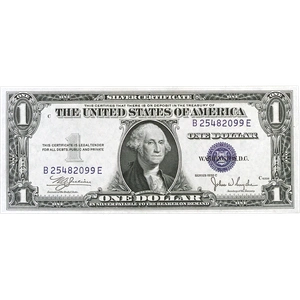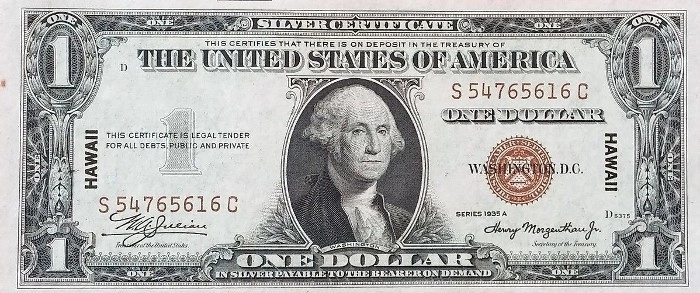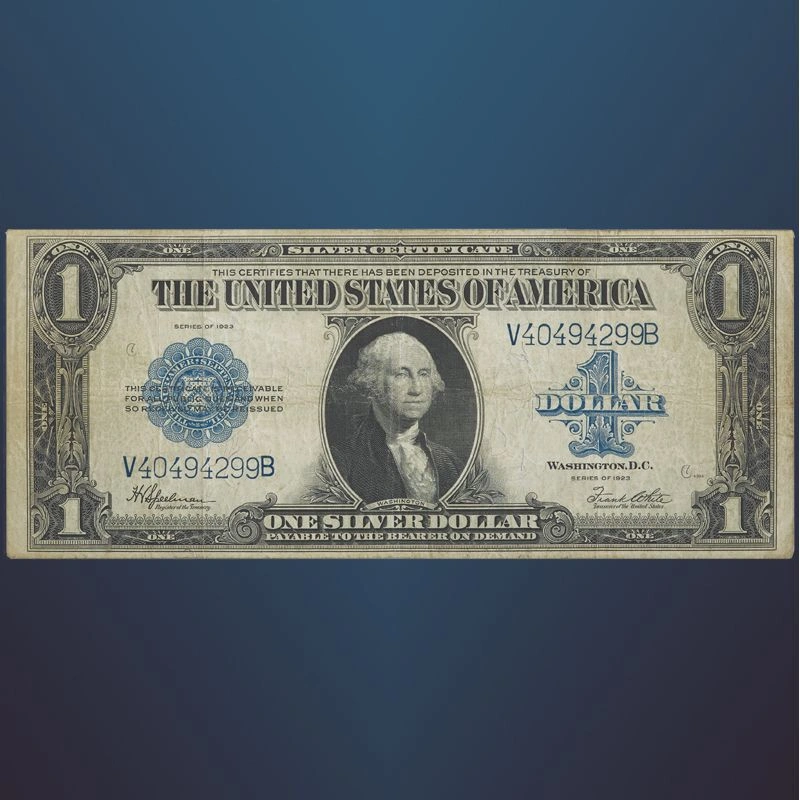Everything You Should Know About Silver Certificate Dollar Bills
Silver certificate dollar bill value has become a hot topic among collectors and history buffs alike. Silver certificates once served as a vital part of the United States currency system. For a time, they could be exchanged for real silver, making them unique compared to other paper money.

Although they’re no longer redeemable for precious metal, silver certificates remain popular among collectors for their historic charm and, in some cases, surprising values. Below, we cover the origin of silver certificates, which ones are worth the most, and tips on how to identify rare silver certificates that might be hidden treasures.
Silver Certificate Dollar Bill Value Chart (2025 Quick Guide)
| Series | Type | Common Value (Circulated) | High-Grade Value (UNC / PMG Certified) |
|---|---|---|---|
| 1935 $1 | Small Size Note | $2 – $5 | $10 – $25 |
| 1957 $1 | Small Size Note | $2 – $5 | $10 – $20 |
| 1928 $1 | Small Size Note (first year) | $10 – $30 | $75 – $150+ |
| 1899 $1 | Black Eagle Note | $50 – $150 | $500 – $1,500+ |
| 1896 $1 | Educational Series | $100 – $300 | $1,000 – $2,500+ |
| 1886 $1 | Martha Washington | $150 – $400 | $1,500+ |
| Star Notes | Replacement Errors | $5 – $50+ | $100 – $500+ (depends on run/block) |
| 1923 $1 | Large Size Note | $20 – $60 | $100 – $400+ |
| $5 & $10 Certs | High Denomination | $50 – $200 | $250 – $1,000+ |
| Error Notes | Misprints / Oddities | $20 – $100+ | $200 – $1,000++ |
1) A Brief History of Silver Certificate Dollar Bills

- Origins (1878–1964)
- First authorized by the Bland-Allison Act of 1878, silver certificates allowed holders to exchange the paper note for an equivalent amount of silver dollar coins.
- The U.S. government aimed to boost silver usage and support silver mining communities, mirroring the logic behind gold-backed currency.
- Design Evolution
- Early series (1878, 1886, 1891) sported elaborate engravings and sometimes large-format designs (often called “Horseblankets”).
- As time progressed, designs became smaller and more standardized, particularly following the 1928 shift to “small size” bills.
- End of Redemption for Silver
- By 1964, the U.S. ceased minting silver coins for general circulation, and official redemption in silver bullion ended in 1968.
- Modern owners cannot trade these notes for physical silver, but they retain collector value due to their distinctive history.
- Why Collect
- Lovers of numismatics and history appreciate the link to the old “silver standard.”
- Eye-catching designs, including the “Educational Series” or “Black Eagles,” enthrall collectors who appreciate artistry and rarity.
2) How Much Is a Silver Certificate Dollar Bill Worth?
2.1 Face Value vs. Collector Value
- Circulated Common Notes
- Most common series from the 1930s to 1950s (e.g., 1935 or 1957) are often worth only slightly above face value if they’re heavily worn.
- Crisp, uncirculated notes can bring higher premiums but still may be under $20 for the most typical issues.
- Rarer Series or High Grades
- Unique star notes, error prints, or scarce signature combinations can climb well above face value, sometimes fetching $50, $100, or more.
- Exceptional older notes from 1899, 1908, or 1923 can be worth hundreds or thousands, depending on grade and rarity.
2.2 Condition Matters in Silver Certificate Dollar Bills
- Grading Scale: Paper money grading services like PMG or PCGS use designations such as VF (Very Fine), EF (Extremely Fine), and UNC (Uncirculated).
- Crispness & Color: Paper quality, bright inks, and minimal folds can significantly raise collector demand.
- Serial Numbers: Fancy or low serial numbers (e.g., 00000123) might catch collector attention even on common series.

3) Rare Silver Certificate Dollar Bills to Look For
Some silver certificates stand out for their limited print runs, unique designs, or historical quirks. Below are examples of rare silver certificates that can command impressive prices:
3.1 Series 1896 “Educational Notes”
- Why They’re Special: Renowned for intricate allegorical engravings, these large-sized notes are often the centerpiece of a paper currency collection.
- Approximate Value: Even heavily worn examples can fetch $100–$300+. High-grade specimens can exceed $1,000.
3.2 Series 1899 “Black Eagle” Notes
- Key Feature: A soaring eagle dominates the center of this large-size note. Underneath, the portraits of Abraham Lincoln and Ulysses S. Grant add further gravitas.
- Approximate Value: Common circulated grades might bring $50–$150, while pristine examples go for much more.
3.3 1928 “Small Size” Notes
- Why They’re Special: This was the first series of small-sized silver certificates. Some varieties and blocks can be scarce.
- Approximate Value: Circulated common types may only fetch $10–$30, but high-grade or rare block letters can escalate values to $100 or more.
3.4 Star Notes and Errors in Silver Certificate Dollar Bills
- Why They’re Special: A “star” in the serial number denotes a replacement note used to correct printing mistakes. Low print runs for certain series or blocks can be highly sought after.
- Approximate Value: Varies widely, from small premiums over face value to several hundred dollars if the note has a combination of rarity and condition.
3.5 High Denomination or Unusual Issues
- Examples: $5 or $10 Silver Certificates, which are less common than the typical $1 notes.
- Value: Higher denominations in uncirculated condition might easily surpass $100.
(Note: Values are approximate and fluctuate based on market conditions, collector interest, and overall grade.)
4) Identifying Genuine vs. Altered or Counterfeit Notes
- Paper Quality
- Vintage silver certificates were printed on distinctive, high-cotton-content paper. Modern fakes might feel too smooth or thin.
- Inspection Under UV Light
- Contemporary counterfeit detectors can reveal if the paper glows unnaturally. Genuine old bills typically don’t have modern security fibers.
- Serial Number and Seal Alignment
- Check for misaligned or mismatched seals, inconsistent font usage in serial numbers, or suspicious coloring.
- Professional Grading
- For high-value or uncertain pieces, third-party graders (PCGS, PMG) confirm authenticity and assign a grade, boosting resale confidence.
5) Building a Silver Certificate Dollar Bill Collection: Tips & Tricks
- Start with Common Dates
- Series 1935 and 1957 $1 notes are abundant and cheap—great for beginners to learn how to handle and store old currency.
- Focus on Condition
- Instead of hoarding dozens of worn notes, aim for a few higher-grade examples of key issues. Condition drastically influences paper money prices.
- Look for Star Notes
- Even within common series, star notes can command premiums. Study print run data to identify short-run blocks.
- Stay Updated on Market Trends
- Check reputable auction sites, attend paper money shows, and read numismatic magazines to keep pace with evolving collector tastes.
- Storage & Care
- Use acid-free sleeves or currency holders to protect notes from moisture, dirt, and bending.
- Avoid staples, rubber bands, or any method that can damage the edges.
Frequently Asked Questions About Silver Certificate Dollar Bills
1. What Is a Silver Certificate Dollar Bill Worth Today?
Common $1 silver certificates from 1935 and 1957 typically sell for $2–$5 in circulated condition. Uncirculated examples can bring $10–$25+. Older and rarer notes—like those from 1896 or 1899—can be worth hundreds or even thousands depending on grade and rarity.
2. Can You Still Exchange Silver Certificates Dollar Bills for Silver?
No. The U.S. government ended silver redemption for these notes in 1968. Today, silver certificates are no longer backed by precious metal, but they retain collectible value due to their historic significance and unique designs.
3. What Makes a Silver Certificate Dollar Bill Valuable?
Several factors drive value: rarity (low print runs or special series), condition (UNC or high-grade), eye appeal, design type (e.g., Black Eagle, Educational Series), star notes, serial number patterns, and printing errors.
4. What Are Star Notes on Silver Certificates?
Star notes are replacements for misprinted bills and are marked with a star in the serial number. They often had shorter print runs, making them rarer and more valuable than standard issues of the same series.
5. How Do I Tell If My Silver Certificate Is Rare or Valuable?
Check the series year, note type, condition, and serial number. Reference value charts or get a professional appraisal. Key series like 1896, 1899, 1928, and star notes are often more collectible.
6. Should I Get My Silver Certificate Graded?
Yes—especially if the note appears to be in excellent condition or is from a rare series. Professional grading (by PMG or PCGS) authenticates the note, assigns a condition score, and can raise its resale value significantly.
7. Are Silver Certificates from 1896 or 1899 More Valuable?
Yes. The 1896 Educational Series and 1899 Black Eagle notes are highly collectible. Even worn examples can be worth $100–$300+. In certified uncirculated condition, they often exceed $1,000 at auction.
8. What Is the Difference Between Large-Size and Small-Size Silver Certificates?
Large-size notes (pre-1928) are physically bigger and feature more elaborate engravings. Small-size notes (1928–1964) resemble modern bills in size. Large-size bills are rarer and generally more valuable.
9. Are $5 and $10 Silver Certificates Worth More Than $1 Bills?
Yes, higher denominations were issued in lower quantities and are harder to find. In uncirculated condition, $5 and $10 silver certificates can be worth anywhere from $250 to over $1,000 depending on the series.
10. How Should I Store Silver Certificate Dollar Bills?
Store them in acid-free, PVC-free currency sleeves or holders. Keep them flat, in a dry, dark place. Avoid using rubber bands, staples, or folding the note—any damage can significantly lower its value.
GoldSilverStacks Key Insights on Silver Certificate Dollar Bills Value
Silver certificates evoke a bygone era when paper money could be traded in for an equivalent amount of silver. Although that direct redemption privilege no longer exists, these bills remain valued pieces of American financial history—and sometimes, they can be surprisingly valuable to collectors. For those curious how much is a silver certificate worth, the answer hinges on factors like rarity, series, condition, and any special features (like star serials or printing errors).
Key Takeaways:
- Common vs. Rare: Most 1935 and 1957 $1 certificates are widely available and often sell for modest premiums over face. Unique series (1896, 1899) and short-print runs command higher prices.
- Grade Matters: Crisp, uncirculated notes with bright ink and minimal folds can raise collector demand exponentially.
- Verification: With altered or counterfeit notes in circulation, authentication by a trusted grading service or seasoned collector is essential for high-value bills.
- Collect for History or Investment: Whether you love the artistry, the nostalgia, or the potential returns, silver certificates can be a rewarding corner of paper money collecting.
If you’re looking to explore numismatics beyond coins, rare silver certificates offer a fascinating gateway into America’s past—balancing aesthetic intrigue with tangible connections to the silver standard.
